- Excavation and General Survey >
- Kaman-Kalehöyük >
- 27th Excavation
Kaman-Kalehöyük
Dr. Sachihiro Omura Director, JIAA
28th Excavation and Survey in Kaman-Kalehöyük (2013)
The 28th Kaman-Kalehöyük Excavation and Survey commenced on 24th June finished on 6th September by depositing 58 excavated artefacts to the Kaman-Kalehöyük Archaeological Museum. Mr. Pınar Irman, the inspector dispatched from the Ministry of Culture and Tourism left the camp on 8th September and it was very nice that through out two months of the excavation and survey period, there had been none of accidents nor incidents.
The excavated artefacts are washed, sorted, picture taken, measured after the excavation and survey in Kaman-Kalehöyük parallel with the artefacts-sorting from Yassıhöyük and the survey of the remains in Kırşehir prefecture. These works would be completed by the end of March.
The Architectural Remains in the North Trench
In the North Trench, the survey was made in two areas: 1) the sectors XVII, XVIII, XIX, XX and XXXIV; and 2) the sectors IV, V, VI and VII.
In the former excavation sectors, architectural remains of the IIa, the Later Iron Age were mainly surveyed and as a result, most of issues that have been outstanding have been resolved. In this season, finding out the relationship between the architectural remains in the sector XX and the fortress found in the sector XXXIV, the Later Iron Age was an objective. Quite a number of marks of hearth were identified in the sector XX. The hearths were put in the same places number of times in the same shape and there found copper slag which are produced during copper smelting process. Stone molds were excavated from the architectural remains in the sector XX.
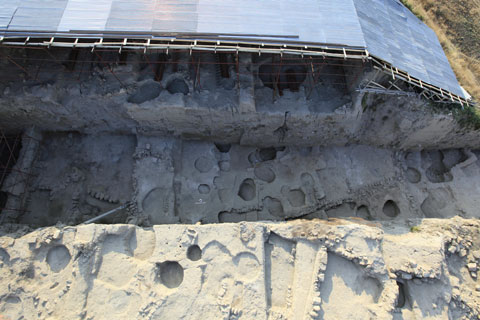
The North Trench
In the previous survey, in the same layers of the excavation sections in the sectors V and VI which are located west of the sector XX, the same shaped marks of hearth, copper slag and molds were excavated. From this fact, there must have been workshops of the Later Iron Age in the sectors V and VI located west of the sector XX.
The architectural remains involving marks of hearth were constructed in the same time of the semi-basement architectural remains located north of them and the semi-basement architectural remains are sticking to the fort. The semi-basement architectural remains must have been constructed after or in the same time the fort was constructed.
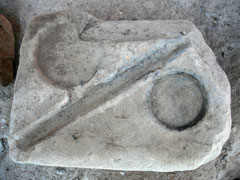
Stone Molds
In the sectors IV through to VII, mainly the IIIc layer, the Assyrian Colony Period, the IVa layer, the Intermediate Period and the IVb, the Early Bronze Age were intensively excavated and surveyed. In this season the architectural remains constructed robustly with the rock work running south to north excavated in the IIIc layer in the sectors V through to VII were removed. Over the past years removal of these architectural remains of the Assyrian Colony Period was made and as a result it has been revealed that those had been renewed and modified number of times. It is recognizable from the west and east sections that in the process of renewal and modifications, the layers of the IVa and IVb were largely cut away.
In the sectors VI to VII, the architectural remains of the IIIc layer were surveyed and to do this the Assyrian Colony Period architectural remains were removed. By doing this, the architectural remains in the IIIc layer were reconstructed several times on the same plan and when doing those, the architectural remains of the IV layer, the Early Bronze Age were largely cut away. As supporting facts, remains and the architectural remains of the IVa layer, the Intermediate Period and the IVb layer, the Early Bronze Age were excavated in the sector VIII and simultaneously the layer which looks to be the continuation of the burnt layer which was identified in the sectors IV and V. In other words, there are burnt layers in the IV layer through to the VIII layer. The cultural layer of the IIIc layer had been accumulated cutting into the IVa layer and the layer belonging to burnt IVb layer, the Early Bronze Age.
The Architectural Remains in the South Trench
In the South Trench survey on the four cultural layers, Ia, IIa, IIc and IId was conducted in the 16 excavation sectors III, XXV, XXVIII, XXX, XXXII, XLIV, XLVI, XLVII, XLVIII, XLIX, LII, LIII, LV, LVI, LVII and LVIII.
There are Ia layer, Ib layer, IIa layer, IIc layer, IId layer and IIIc layer are identified in the South Trench. Among these series of layers, at the moment survey focusing on the IIc layer and the IId layer has been conducted. In this season, removal of the architectural remains in the Ia layer and the IIa layer which are located just above the layers IIc and IId and were identified in the previous excavation and survey at the IIc and IId layers were exercised.
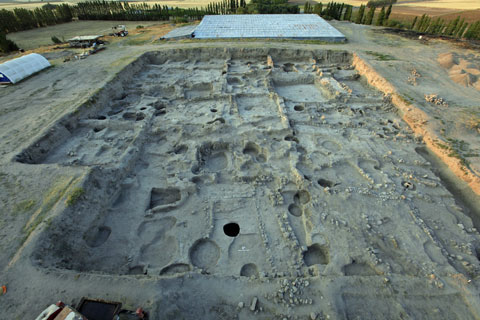
The South Trench
In the sector XXVIII, semi-basement architectural remains which is one of the peculiarities of the Ia layer were identified and also the architectural remains of which preservation conditions are poor were identified. There are number of earthenware such as grey earthenware like Krater which are often found in the IIa layer on the floors of the architectural remains in the IIa layer.
Excavation in the IIc and IId layers, survey to the sectors XXXV, XLVI through to XLIX, LII through to LIII and LV through to LVIII was exercised. Storage belonging to the IIc layer, R59 and R181 were identified in the sectors XLVIII and LIII. It is rectangular of 10m sectors north to south and west to east and is of rock work wall. In the survey last year, wheat was found on the floors of this storage, which has been reconfirmed that this was a storage for grain. There found painted earthenware with stylized deer which is peculiar to the IIc layer in each storage and consequently it is assumed that the remains could be of the IIc layer or one earlier age than that of the IIc layer.
In the sector LIII, IIc layer which was scraped when R59 was built, or in other words, a part of the architectural remains of the Assyrian Colony Period and a burnt layer were identified. It is assumed that those architectural remains and burnt layer are parts of the large scale architectural remains of the Assyrian Colony Period which were found at the sectors 0 through to II, XII and others in the North Trench.
IId layer is of the age used to be named the “Dark Age “ in the Anatolian Archaeology. In other words, this age is the Early Iron Age after the Hittite Empire was broken down. In this season, survey to the sectors XXXII, XXXIV, XLVI through to XLVII, LII through to LIII and LV through to LVIII was exercised in relation with the IId layer. In the IId layer in the South Trench, at least four architectural remains were identified. One of peculiarities of these architectural remains is that all of them were burnt. In the excavation, survey to the dug out one burnt layer one by one has been exercised and these remains are looked to be relatively complex due to those being repeatedly repaired and extended.
The matters clear from the survey in the last several years are the culture of the IIc layer inherits the culture of the IId layer and semi-basement architectures are under strong influences from the IId layer to the IIc layer. There also became clear that the settlements in the IIc layer and the IId layer are more in the South Trench than in the North Trench. In the Early Iron Age after the Hittite Empire was broken down, there grew settlements on the south side of the hill.
Looking at the architectures in the IIc layer and IId layer, private architectures as well as public use architectures, which is judged from their sizes, are identified as peculiarity. There is an issue if the culture in the IId layer was built inheriting the IIIa layer, the culture of the Hittite Empire, however, there has not been found any cultural elements of the IIIa layer in the culture of the IId layer. The culture of the IId layer rose in central Anatolia independently from the culture of the Hittite Empire after its broken down. It is assumed from the survey exercised in the remains of central Anatolia that the culture in the IId layer came into the center of Anatolia from the south side.
Excavated Remnants
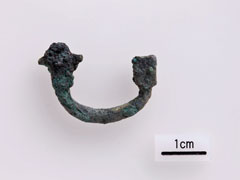
Fibula
Relics excavated during the excavation and survey in the North and South Trenches range widely.
Some of the relics excavated in the Ia layer of the South Trench are fragments of green glazed earthenware and iron products. In the IIa layer, painted earthenware, bronze products and iron products were excavated.
There are bronze fibulae, arrow heads and swards. In the IIa layer in the North Trench, much of metal slag and stone molds were found. Especially the stone molds are made of sand stone and found in the architectural remains which are supposed to have been workshops. In the IIc layer in the South Trench, many fragments of earthenware painted with stylized deer as motif are excavated. In the IId layer, relatively large number of iron products for instance knife shaped ones and painted earthenware have been excavated.
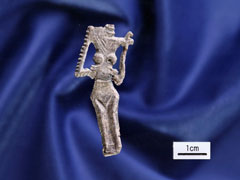
God Statue made of Lead
In the IIIc layer in the North Trench, bronze pins, god statues made of lead, earthen spindle wheels and red polished earthenware have been excavated. In the IVa layer which is located just beneath the IIIc layer, in other words the Intermediate Period, hand twisted small size earthenware with ear together with red polished earthenware have been excavated. In the IVa layer, the Early Bronze Age, more or less 10 hand twisted earthenware with no figures and of the Alişar third style and fragments of earthenware of the intermediate Period have been excavated. The paint styles of the Alişar third style earthenware are all of the later era.
Towards the Following Year
There found iron related materials have been excavated in the North Trench and analysis on those would be made as soon as returned to Japan. The excavation and survey for the following year would be planed based on the results of the analysis. Regarding the IVb layer, the Early Bronze Age, excavation and survey would be conducted in the deepest parts of the sectors III through to VIII in the North Trench. In the South Trench, the IIb layer will be more intensively surveyed than the IIc layer.
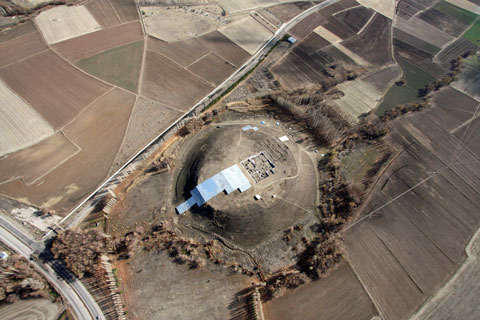
Remains of Kaman-Kalehöyük (Aerial Photography)
Acknowledgements
The excavation and survey in Kaman-Kalehöyük has been supported by many of supporting bodies by ways of subsidies and aid money. We are grateful for all such supports extended to us and the following are names of bodies subsidized in 2013.
- Japan Keirin Association

- Sumitomo Foundation
- Foundation for Cultural Heritage and Art Research
- Mitaka City
The Progress of the 28th Excavation and Survey in Kaman-Kalehöyük (2013) (2)
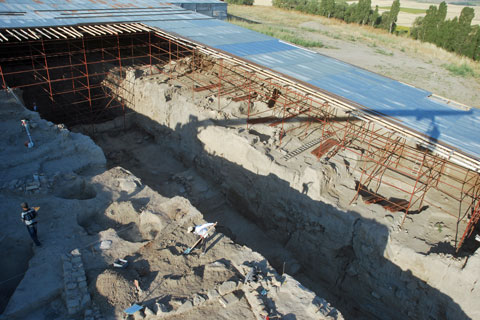
The North Trench
The 28th excavation and survey in Kaman-Kalehöyük started on 24th June is coming to its last stage. There going on active survey in the North and the South Trenches.。
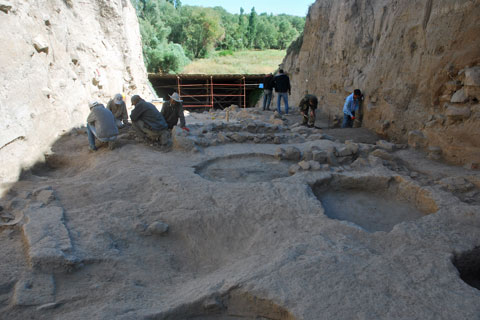
The North Trench
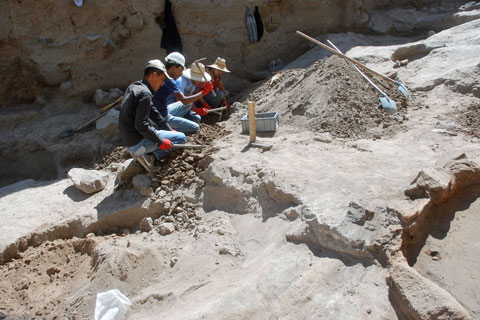
The North Trench
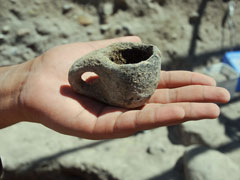
The Excavated Earthenware in the North Trench
In the North Trench, as reported in the last report, the cultural layers of the Early Bronze Age in the 3rd millennium B.C. have been intensively surveyed. In the pit identified in the sector V, a large pottery was excavated and nearby it, human bones of a person were excavated. Observing this large pottery, it resembles to the one excavated in the ruin of the palace in Yassıhöyük year before in its shape. Most of the earthenware excavated this season in the sectors IV through to VI in the North Trench are hand twisted ones and there are few of them produced on the potter’s wheel. The sectors XVIII through to XX in the North Trench have been surveyed and excavation of the architectural remains of the Later Iron Aage have been the areas much of efforts have been given. It has been surveyed to make clear the relationship between the architectural remains of the Later Iron Age which were excavated this time and the fortress, however, contrary to anticipation the remains of workshops of the Later Iron Age were found. There found many molds attached with metal slag in the remains.
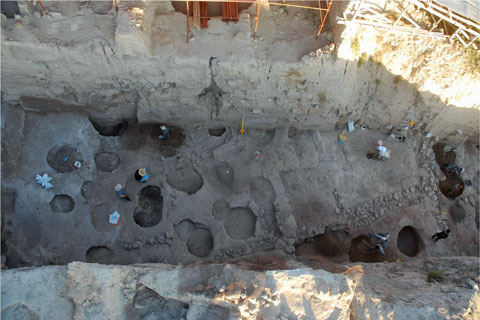
The North Trench
In the South Trench, the IIc layer of the 9th century BC through to the 8th century BC and the IId layer which is located just beneath the IIc layer have been surveyed and the cultural layer of the IId layer is much thicker than anticipated and most of five layers identified are burnt. Many painted earthenware have been excavated and the relationship between the IId layer and the IIIa layer, the Hittite Empire would be clarified. The excavation and survey till now could not indicate the relationship of these layers. There comes hypothesis that there must have been blank period between those two layers.
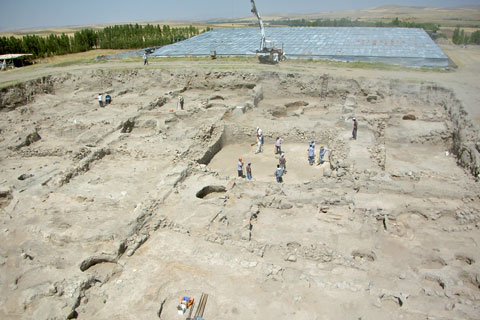
The South Trench
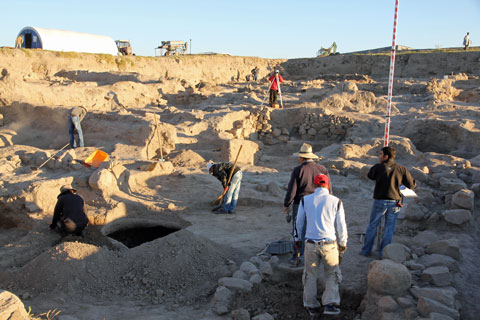
The South Trench
It is planed that the excavated remnants would be deposited to the Archaeological Museum of Kaman-Kalehöyük on 7th September and the 28th excavation and Survey would be finished. (Sachihiro Omura)
The Progress of the 28th Excavation and Survey in Kaman-Kalehöyük (2013) (1)
The excavation and survey started on 17th June got into the 6th week. In spite of heat wave once, the excavation works progress in good order. In the first week, removal of the protection roof of the excavation sections and cleaning of the sites were made and in the second week, the excavation and survey stared. In this season in the North Trench, the objective of the survey is to compile “cultural stratigraphy” and in the South Trench, “clarification of the settlements in the Iron Age”.
In the South Trnch, the IId and IIc layers which are of the Early Iron Age and of the Middle Iron Age respectively are being excavated. Especially five architectural layers were identified in the IId layer which has been named in the Anatolian Archaeology as “Dark Age”. The IId layer has been surveyed following the burnt layers. On the other hand precise survey has been exercised on the remain structures which are considered to be grain storages in the IIc layer of Middle Iron Age.
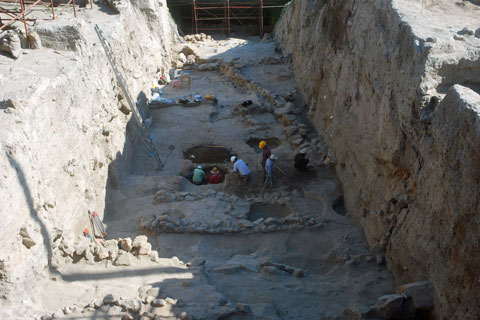
The North Trench
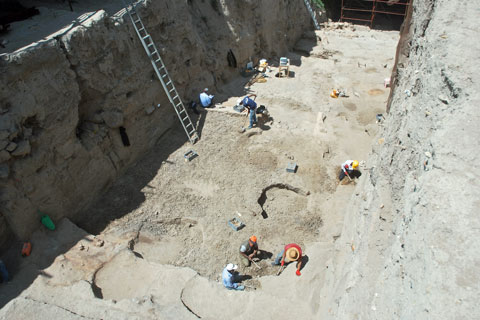
The North Trench
In the South Trnch, the IId and IIc layers which are of the Early Iron Age and of the Middle Iron Age respectively are being excavated. Especially five architectural layers were identified in the IId layer which has been named in the Anatolian Archaeology as “Dark Age”. The IId layer has been surveyed following the burnt layers. On the other hand precise survey has been exercised on the remain structures which are considered to be grain storages in the IIc layer of Middle Iron Age.
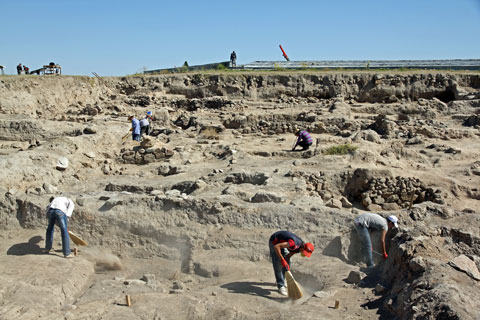
The South Trench
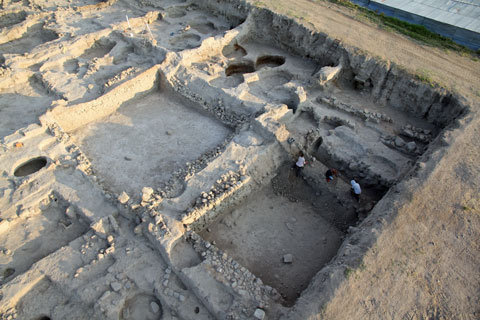
The South Trench
Earthenware, bronze products, iron products, molds and so forth have been excavated.
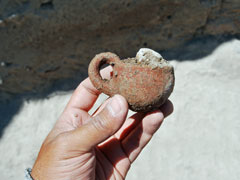
Excavated earthenware in the North Trench
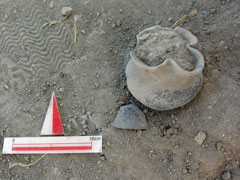
Excavated earthenware in the South Trench
The 28th excavation and Survey in Kaman-Kalehöyük (2013) Commenced
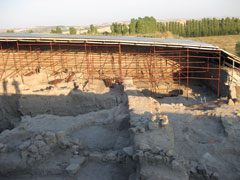
Protection Roof
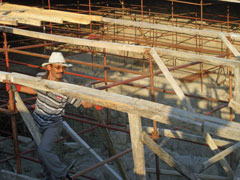
Removal of the Protection Roof
The 28th excavation and survey in Kaman-Kalehöyük commenced as of 17th June. The protection roofs on the North and the South Trenches were removed as from 17th through to 22nd of June. They were put on the sectors after the excavation and survey were finished last year. The preservation conditions of the architectural remains were much better than anticipated because of the protection roofs. Each excavation sector was cleaned up till the end of last week.
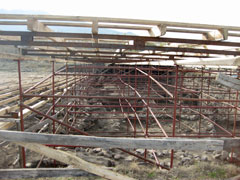
Protection Roofs
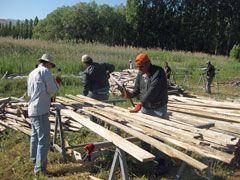
Tidy up Frames of the Protection Roofs
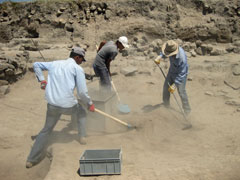
The South Trench
Objectives of the excavation and survey this season are to “compile cultural stratigraphy” in the North Trench and to “grasp the style of settlements in the Iron Age”. These objectives are similar to the ones last year. The IIIc layer in IV through VIII sectors – the Assyrian Colony Period, IVa layer – the Intermediate Period, IVb layer – the Early Bronze Age, IIa layer in XIX through to XX sectors and the IId layer in the Early Iron Age would be excavated and surveyed. Many workers have been hired from Çağırkan village where the Japan Anatolian Archaeological Institute is as last year and this year very many applicants came and it was rather hard work to select for hire. Excavation started on 26th June and the temperature in Central Anatolia is rising rapidly since a day before yesterday. Today temperature went over 40 degrees C. Fighting against heat has also commenced. (Sachihiro Omura)
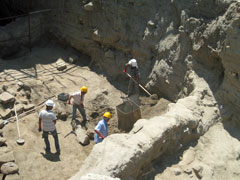
The North Trench
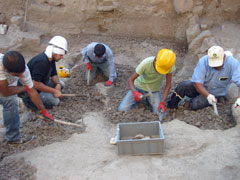
The Excavation